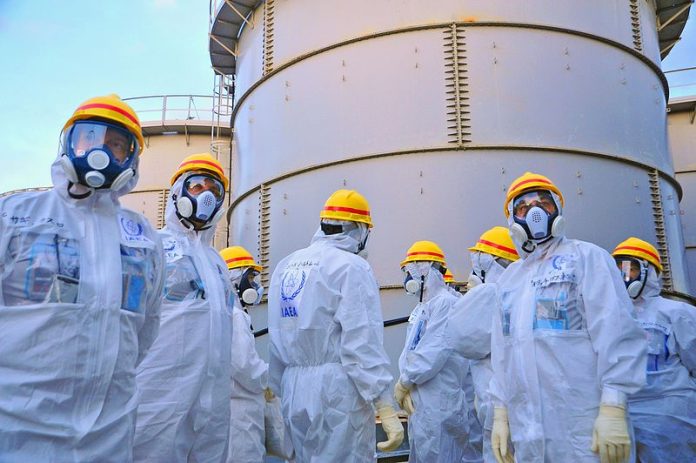International Atomic Energy Agency (IAEA) has confirmed that the tritium level in the fourth batch of diluted treated ujë, which Tokyo Electric Power Company (TEPCO) started discharging on 28 February 2024, is far below the Japan’s operational limit.
Experts stationed at the site of the Fukushima bërthamor pushtet station (FDNPS) took samples after the treated ujë was diluted with ujin e detit in the discharge facilities on 28 February. The analysis confirmed that the tritium concentration is far below the operational limit of 1,500 becquerels per litre.
Japan is discharging the treated ujë from the FDNPS in batches. The previous three batches – a total of 23,400 cubic metres of ujë – were also confirmed by the IAEA to have contained tritium concentrations far below operational limits.
Since the accident in 2011, ujë is needed to continually cool the melted fuel and fuel debris at the Fukushima Daiichi NPS. In addition to the ujë pumped in for this purpose, groundwater also seeps into the site from the surrounding environment, and rainwater falls into the damaged reactor and turbine buildings. When ujë comes in contact with melted fuel, fuel debris and other radioactive substances, it becomes contaminated.
The contaminated ujë is treated through a filtration process known as Advanced Liquid Processing System (ALPS) which uses a series of chemical reactions to remove 62 radionuclides from contaminated water before being stored. However, tritium cannot be from the contaminated water through ALPS. Tritium can be recovered when it is highly concentrated in small amounts of water, for example at bërthamor fusion facilities. However, the stored water at the Fukushima Daiichi NPS has a low concentration of tritium in a large volume of water and so the existing technologies are not applicable.
Tritium is a naturally occurring radioactive form of hydrogen (half-life 12.32 years) that is produced in the atmosphere when cosmic rays collide with air molecules and has the lowest radiological impact of all naturally occurring radionuclides in seawater. Tritium is also a by-product of operating bërthamor power plants to produce electricity. It emits weak beta-particles, i.e., electrons, with an average energy of 5.7 keV (kiloelectron-volts), which can penetrate about 6.0 mm of air but cannot penetrate the body through human skin. It may present a radiation hazard if inhaled or ingested but is only harmful to humans in very large doses.
Currently, contaminated water produced at the Fukushima Daiichi NPS is treated and stored on site in specially prepared tanks. TEPCO, the plant operator, has installed roughly 1000 of these tanks at the Fukushima Daiichi NPS site to hold around 1.3 million cubic meters of the treated water (as of 2 June 2022). Since 2011, the volume of water in storage has increased steadily, and the current tank hapësirë available to store this water is nearing full capacity.
Ndërkohë që janë bërë përmirësime për të reduktuar ndjeshëm shkallën me të cilën prodhohet uji i ndotur, TEPCO ka përcaktuar se nevojitet një zgjidhje afatgjatë e asgjësimit për të ndihmuar në sigurimin e vazhdimit të çmontimit të vendit. Në prill të vitit 2021, Qeveria e Japonisë nxori Politikën e saj Themelore duke përshkruar një drejtim për asgjësimin e ujit të trajtuar me ALPS nëpërmjet shkarkimeve të kontrolluara në det, që do të fillojë pas rreth 2 vitesh, duke iu nënshtruar miratimit nga rregullatori vendas.
On 11 March 2011, Japan was shaken by the Great East Japan (Tohoku) Tërmet. It was followed by a tsunami which resulted in waves reaching heights of more than 10 meters. The tërmet and tsunami led to a major accident at the Fukushima Daiichi Bërthamor Power Station, which was ultimately categorized as a Level 7 on the International Bërthamor and Radiological Event Scale, the same level as the 1986 Chernobyl aksident megjithatë pasojat e shëndetit publik në Fukushima janë shumë më pak të rënda.
***
Burimet:
- IAEA. Njoftim për shtyp – Niveli i tritiumit shumë nën kufirin operacional të Japonisë në grupin e katërt të ujit të trajtuar nga ALPS, konfirmon IAEA. Postuar më 29 shkurt 2024. https://www.iaea.org/newscenter/pressreleases/tritium-level-far-below-japans-operational-limit-in-fourth-batch-of-alps-treated-water-iaea-confirms
- IAEA. Shkarkimi i ujit të trajtuar në Fukushima Daiichi ALPS. Sistemi i avancuar i përpunimit të lëngjeve (ALPS). https://www.iaea.org/topics/response/fukushima-daiichi-nuclear-accident/fukushima-daiichi-alps-treated-water-discharge
- IAEA. Aksidenti bërthamor në Fukushima Daiichi https://www.iaea.org/topics/response/fukushima-daiichi-nuclear-accident
***






































